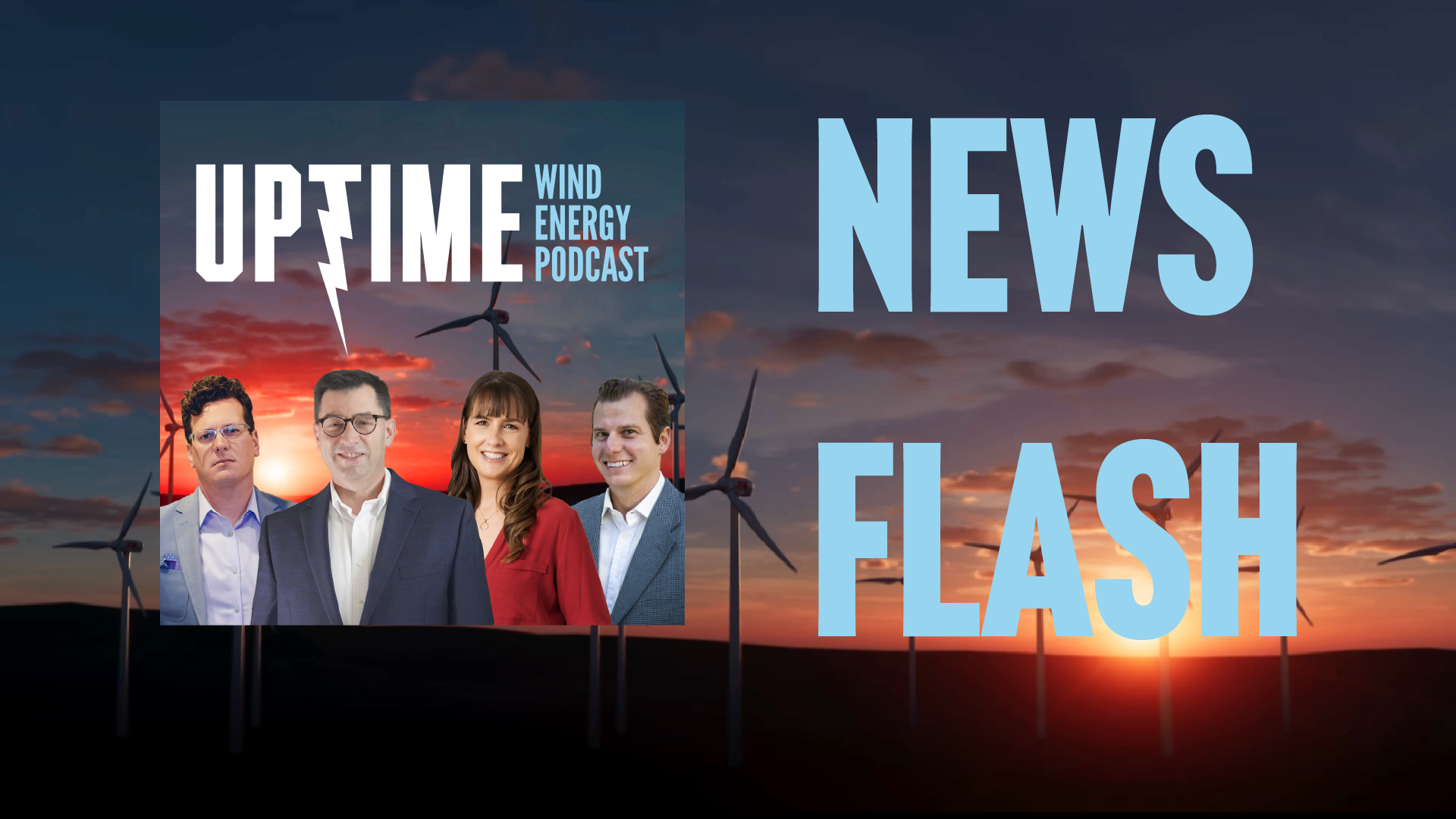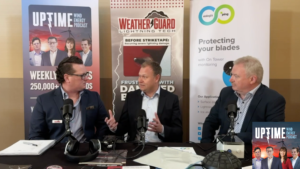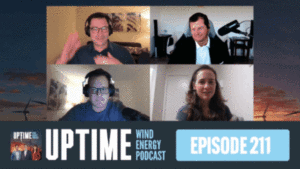Podcast: Play in new window | Download
General Electric splits into GE Vernova, GE Aerospace, and GE Healthcare, Macquarie Asset Management’s Corio Generation invests $50 billion in offshore wind, Mingyang plans a turbine manufacturing facility in Scotland, Avangrid’s offshore wind project is approved by the U.S. Interior Department.
Sign up now for Uptime Tech News, our weekly email update on all things wind technology. This episode is sponsored by Weather Guard Lightning Tech. Learn more about Weather Guard’s StrikeTape Wind Turbine LPS retrofit. Follow the show on Facebook, YouTube, Twitter, Linkedin and visit Weather Guard on the web. And subscribe to Rosemary Barnes’ YouTube channel here. Have a question we can answer on the show? Email us!
Pardalote Consulting – https://www.pardaloteconsulting.com
Weather Guard Lightning Tech – www.weatherguardwind.com
Intelstor – https://www.intelstor.com
Allen Hall: I’m Allen Hall, president of Weather Guard Lightning Tech, and I’m here with the founder and CEO of IntelStor, Phil Totaro, and the chief commercial officer of Weather Guard, Joel Saxum. And this is your News Flash. News Flash is brought to you by our friends at IntelStor. And if you want market intelligence that generates revenue, then book a demonstration of IntelStor at IntelStor.com.
Macquarie Asset Management, through its fully owned offshore wind unit, Corio Generation, is making a fantastic investment. 50 billion investment in offshore wind over the next seven years. Corio generation, along with partners like TotalEnergies plans to invest in markets, including New York, New Jersey, Scotland, England, Taiwan, and Ireland.
Phil, they’ve hit all the hotspots for offshore wind, but putting 50 billion into that marketplace is massive.
Philip Totaro: Yeah. And keep in mind that, we’re talking about a market that is likely to be several trillion dollars over the next five to seven years. They’re certainly doing their part but also keep in mind that Corio has only really existed, obviously backed by Macquarie Group, but has only really existed for about the past year.
I think they just celebrated their one year anniversary very recently. They’ve come quite far in a short period of time with the deployment of the capital that they’ve got and the markets that they’re looking at are absolutely, the places You want to be, now that the U S has gotten through most of its nonsense and we’re getting back on track this is a good market to be in Taiwan’s relatively stable.
There’s a few kind of concerning signals out of there. But for the most part, that’s going to still continue to grow and then England and Ireland are absolutely growth markets with a huge pipeline of projects in both those countries.
Joel Saxum: 50 billion over the next seven years is their plan.
Right now, and correct me if I’m wrong, Phil, but a gigawatt offshore wind farm, fixed bottom, costs between 3 and 5 billion to build, probably about 4 billion. Does that sound about right?
Philip Totaro: CapEx costs on an offshore fixed bottom is probably somewhere between 2. 5 and 3 million per megawatt. You can, But yeah, your typical sized project at this point, if it’s around a gigawatt in size you’re talking about, 3 billion.
Joel Saxum: Okay, so we’re looking at 15 gigawatts of generation that they could get installed with that 50 billion or something around that. That’s huge. That’s that will help some countries in some areas hit some generation goals for offshore wind, definitely. And another one to mention here as well, we mentioned on the podcast the other day, but Onyx Insight recently purchased by Macri as a whole.
They’re also bringing in advanced analytics and tools to the Wind farms that they’re installing.
Allen Hall: The Scottish Offshore Wind Energy Council added seven new projects, including a Mingyang facility, to the Stage 2 Strategic Investment Model list, which aligns supply chain with developers plans for the ScotWind leasing round.
Mingyang’s presence on the SEM program has proven controversial, raising concerns about potential negative impacts on Scotland’s energy security and relationships with the industry. The European turbine OEMs if the Minyang project proceeds, it would be the first turbine manufacturer facility built in the UK with reports suggesting Vestas may be considering a plan for a facility in Scotland.
Phil, if Minyang does plan a facility in the UK, that is really earth shattering because European Union has been opposed to that for the longest time. What is the likely outcome here?
Philip Totaro: Yeah, this is a really interesting twist because obviously they’ve been targeting markets like the UK and Germany for a while, and they just recently had a meeting in China with the CEO of TotalEnergies which has helped to foment this idea that, they’re going to be expanding their footprint globally.
What’s fascinating about this, though, is, you can look at the Chinese as either a threat or an opportunity. And the reality of this is that countries that say we, we don’t want the Chinese here then invest in the European or invest in the American companies that are doing the work or have the ability to do the work.
They want cheap goods, but they don’t want China. That’s what China brings to the table is cheap goods. So if you want cheap goods, then work with the American companies to figure out a way to make cheaper goods, try to eliminate some of the legacy pension costs and, union labor costs and things like that, that drive up, the cost of doing business in Western markets.
You can’t have it both ways. The government wants tax revenue. The government wants jobs. The Chinese are offering you money. Are you going to take it or not?
Joel Saxum: Yeah, coming off of Wind Europe just a few weeks ago one of the biggest messages from the, some of the large Western OEMs was hey, how are we keeping this, the Chinese competition out of here?
And and you can flag different laws and different fair trade acts and those kinds of things with not playing on the same 100 percent correct. Click. They’re going to, they’re, the latest reports are the 30 percent of the cost for some of these onshore wind turbines.
Offshore probably won’t be that much different. So they have Chinese built vessels, Chinese steel, Chinese built turbines. You’re going to bring in, and you can bring in Chinese labor if you want to, right? So everything is cheaper. And so the European, the OEMs are complaining that it’s not fair on the same grounds.
If you want it to be fair, it’s not fair. Then you have to figure out how to compete globally. As the markets globalized more and more you have to figure out a way to even the playing field because eventually the economics will just work out. And in, in this case, the economics will end up working out in the favor of the Chinese.
Allen Hall: The U. S. Interior Department has approved the country’s eighth commercial scale offshore wind project, which is Avangrid’s New England Wind Project, which will be built off the coast of Massachusetts. The project will bring online power to roughly 900, 000 homes. And brings the U. S. one third of the way to President Joe Biden’s goal of permitting 30 gigawatts offshore wind by 2030.
Phil, as we get closer to election time, the 30 by 30 gigawatts as we get closer to election time, the 30 gigawatts installed by 2030 isn’t going to happen. But are we seeing a shift in the way that they’re describing the 30 by 30 where now we’re talking about just permitting the 30
Philip Totaro: Potentially but I will say this is the approval of this, which they said they were going to undertake the their, BOEM’s analysis about five weeks ago.
This is the fastest I think I’ve ever seen the government move on practically anything. When’s the last time the government did anything in about five weeks? They’re really getting their act together, and making sure that. These projects, which there’s a bunch of them in the queue get approved.
And the impact of this is, it provides some certainty and stability to not only the project developers who want to lock in the high price that they can get on a PPA right now that we’ve gone through all the malaise of trying to renegotiate PPAs in New York and New Jersey and all this kind of stuff.
Right now is the time to lock in a power purchase contract if you’re an offshore wind developer. So you want to get the government, to kick things into high gear and get these approvals going. But the reality is, prices, PPA prices are going to come down in the future when interest rates are going to come down.
And plus economies of scale will necessarily be achieved on the technology. So the time to lock in your PPA prices now, and the faster that the government goes with reviews and environmental permits, the faster the projects get to a point where they can negotiate offtake agreements, get PPAs locked in, and get the projects in the water.
This is particularly, as Allen mentioned, something that companies want to do in anticipation of a potential change in the political landscape come November and in January next year.
Joel Saxum: Phil, I can give you one thing that the government does faster than this is ask for my taxes, because they’re doing that really quickly.
But yeah, 100%, when we see these things, when you look at the past track record of approving these offshore wind leases, or even looking at, doing assessments, they move at a snail’s pace. And now we have an election staring us in the face on November 11th, and there’s, the pressure’s heating up, and now, this is just my opinion, right?
There’s, both sides of the aisle want wins. They want win, win. So right now you can say, hey, we promised this, and we, now we’re delivering on it, we’re permitting this, and we’re permitting that. So I think that’s a big driver of getting these things done quickly. I think in the next six months you’ll see quite a few other projects go the same way.
Allen Hall: The General Electric Company completed its plan to split into three separate companies, with GE Vernova becoming a separate entity and trading on the New York Stock Exchange under the symbol GEV. The remaining GE has become GE Aerospace while GE Healthcare was split off as a separate public company in early 2023.
GE Vernova CEO Scott Straszak stated that the company is singularly focused on accelerating the energy transition to a more sustainable future. Phil, this obviously has implications around the Northeast because that’s where GE Vernova is based and connected in New York and also in Cambridge, Massachusetts near me.
This is a Big deal and it still seems like G. E. Vranova is trying to make sure they’re going to be stable over 24 and 2025. How do you see this playing out in the near future?
Philip Totaro: Yeah, it’s an interesting question because normally when a big conglomerate breaks up, it’s it doesn’t always go well to be perfectly blunt and certainly, equity analysts around the world are looking at this and saying we hope it works out.
The one thing that GE’s Vernova’s got going in its favor is they have an already healthy onshore wind business. It’s not necessarily the bulk of their revenue for GE Vernova. Cause again, they have other power generation related businesses folded into this now. But the fact that they’ve got, a profitable onshore wind business is good, their offshore wind business, not yet profitable, but is, planned to be.
And the fact that they’ve also decided to focus on. They’re pre existing product platforms for offshore and not keep chasing size. A company that has a size of turbine, like a 12 megawatt or a 15 and a half megawatt offshore turbine that can be installed by the available vessels is going to help them get more projects and get profitability on their offshore business faster.
So I think this is going to work out pretty well. As far as their, power generation business goes. And again, assuming that they’re, highly committed to this energy transition. I think they’re in a fairly good position.
Joel Saxum: If you look at the stock tickers for the two companies that they split up, GE Aerospace, which is now trading under the NYSE symbol of GE, and GE Vernova, which is trading under the stock symbol of GEV, GE Aerospace stock is actually up a few percentage points.
It’s up 4 percent since they came out and it’s, there’s a couple of little rises and falls, but it looks like it’s trending in that direction. That positive way. And over the last few days, since they did debut, the GE VE stock is down 2 percent and it’s trading fairly flat. Now we’re talking micro macro.
This is two days of trading. That’s it. But what it looks like is the markets see that the, they ha they’re happy that aerospace has split off by itself and they’re putting a little bit more money into that. And the GE Vernova side has stayed fairly flat.










